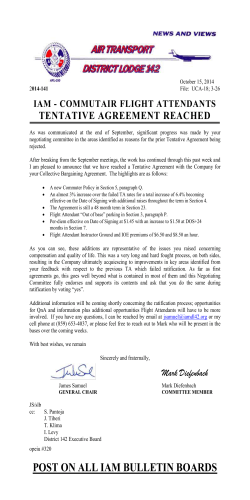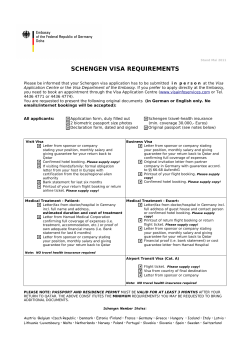
Flying to the United States
Flying to the United States By VFC instructor Tristan Nano - please email any questions or corrections to [email protected] Pilot must have: 1. Valid Private pilot, CPL, ATPL licence 2. Valid Medical certificate – Note: Canadian Medical not valid more than 24 months outside of Canada! 3. Restricted radio operators certificate 4. Passport 5. Print off of APIS Notification of Receipt of Transmission emailed to you If not Canadian or US citizen, call ahead and make sure all documents are in order. Procedure may not be similar to commercial air travel. Aircraft must have: 1. All required documents per normal flight: C of A, C of R, proof of insurance, W&B, journey log, etc 2. Mode C transponder, two way radio Flying to the USA Before takeoff 1. Complete eAPIS Notice of Arrival min one hour prior to departing Canada. See eAPIS notes later. 2. File notice of arrival and/or landing rights by phoning customs at airport of arrival. Some require as little as 1 hour notice prior to arriving and up to 24 hours for others. 3. File a Canadian flight plan – do not use the “advise customs” option. After takeoff 1. I recommend Flight following when in the USA when not flying in a CZ – basically an approach or centre controller watching over you, and handing you off to the next frequency, traffic information etc, as their workload permits. Example of transmission: Whidbey approach Skyhawk CFMEK Skyhawk CFMEK, Whidbey approach, Whidbey altimeter 30.14 CFMEK 8 miles south of Friday Harbour 5,500’ requesting flight following to Boeing field with handoff to Seattle approach. CFMEK, squawk 3054 CFMEK squawking 3054 Few moments later: CFMEK, RADAR contact, Friday Harbour, 12 miles southwest of, 5,500. CFMEK, position and altitude checks Some time later: CFMEK contact Seattle approach 120.6 CFMEK switching 120.6 Seattle Approach Skyhawk CFMEK with you 5,500 VFR CFMEK Seattle approach roger, Seattle altimeter 30.16 information Charlie for Boeing [They don't always remind you to stay clear of the bravo] CFMEK The controller may or may not ask if you would like handoffs to other controllers, so you probably want to say yes. In that case, you would (in this situation) be handed off to Seattle approach then finally Boeing tower if they weren’t too busy. It is your responsibility to remain clear of the class B airspace that goes as low as 1100 near KBFI even if it seems implied you are cleared into it. The controller must say the words “Cleared into the bravo” to enter as CVFR. It is a good idea to read back all the instructions and clearances while operating under flight following and especially if cleared into the bravo airspace. If you are under flight following clear of class B you are permitted to start a descent to destination without permission unless they say advise altitude change. 2. Establish contact with control tower as per normal 3. After landing, taxi to customs and shut down, do not exit aircraft or even open the door! Customs won’t be happy if you are more than 5 minutes early or 15 minutes later, however it is better to be late than early. Have all documents ready. 4. Close flight plan via the nearest FSS station (i.e. Seattle radio 122.5) or by phone if there is no reception. Flying to Canada Before Flight 1. Report the estimated time of arrival by calling 1-888-CANPASS (1888-226-7277) at least two hours, but no more than 48 hours before arriving in Canada. Should the 1-888 service not be available, pilots must call using normal business numbers for the appropriate Telephone Reporting Centre (TRC Victoria: (250) 363-0222) 2. Submit notice of Departure on eAPIS website min 1 hour prior to departing. (note: you can do this before leaving Canada if you know when you're returning). If you grossly misjudge this time, you will need file a new notice of departure. (technically +/- 15 minutes of crossing border) 3. File a US VFR flight plan by phone 1-800-WX BRIEF: see attached guide Departure procedures 1. For class B or C airports, contact Clearance delivery just like in YYJ. They likely will assign a departure frequency (same as our terminal). For other controlled airports, contact ground and simply state in the taxi request the direction of flight. Clearance delivery is used for IFR only in class D. (Example: Boeing ground Skyhawk CFMEK Galvin taxi departure to the Northwest with Delta) 2. ACTIVATE FLIGHT PLAN via radio! Pilot must activate flight plan by calling the nearest FSS station and saying the words ``Activate flight plan``. Best to do this right after you run-up prior to takeoff otherwise it can be a difficult to juggle several frequencies or even worse, forget. 3. Copy down the border crossing transponder code on paper, keep your transponder on 1200 or the assigned code by ATC for the time being. 4. When calling tower ready for takeoff, most will again ask direction of flight so I say it again (i.e.: westbound). If told to hold short, read back full hold short instruction or they likely will make you say it full. "Tower CFMEK ready takeoff runway 13 left northwest bound" 5. Contact departure frequency for flight following if desired. 6. Generally Whidbey approach doesn't hand you off until right at the Canadian border (also terminal class C airspace border) so in this case I cancel flight following 5-10 miles before the border to contact terminal. If they tell me to squawk VFR I actually switch to the boarder code assigned by FSS. Otherwise the discrete flight following code is fine to keep. "Approach CFMEK cancel flight following" 7. On arrival YYJ, taxi to the Shell Aerocentre and call the canpass number if no agents are on site. Try not to be more than 5 minutes early or 15 minutes late or you will get a small lecture. 8. Close flight plane with Canadian F.I.C. A few quick differences between US and Canada 1. ATC often clears aircraft to land but in sequence; for example, you may be cleared to land but number 5. 2. You must call FSS by radio and activate your flight plan, tower cannot do this. Find the nearest RCO on the chart. 3. Cessna 172 is called a Skyhawk because their registrations have numbers so they avoid saying the model number. There is nothing wrong with calling yourself a 172 but may catch a few controllers and you will be different. 4. Instead of CYR and CYA they have restricted and warning areas. 5. Flights within the USA do not require a VFR flight plan, regardless of distance. 6. When talking to a centre controller, it is best to give location by referencing a VOR station, so: VOR name, radial number and DME distance. 7. When flying into an uncontrolled airport, aircraft usually join the circuit via 45 degree entry onto downwind. If there is no AWOS, you must fly at least 500’ above the circuit then descend well clear the circuit. For airports with one runway and circuits on one side, it is not wrong to cross midfield at circuit alt and then join into the downwind directly. Straight ins are fairly common as well - basically keep your eyes open and make frequent radio calls. 8. Instead of 126.7, frequency 122.0 (called “flightwatch”) is used for similar purposes for weather and PIREPS. When contacting on initial transmission, say nearest VOR station. Contact nearest FSS station for flight plan changes. For flight plan amendments call nearest FSS station. 9. When calling on a approach or centre frequency keep in mind the controller may be using several frequencies so it may be a few minutes before even getting a response. 10. There are many more small differences such as VFR minimums, VFR OTT, etc. Consult a US AIM for regulations. 11. Skyvector.com gives free current US charts, the FAA flight directory online, and airport weather. 12. AirNav.com provides a great pilot information source for airports plus fuel prices, hotels, pictures etc. 13. If flying to Seattle Boeing Field, remember: TPA (Traffic Pattern Altitude) RWY 13L/31R 1000 MSL; RWY 13R/31L 800 MSL. Also the circuit is fairly close in to the airport for the long runway due to SEATAC. 14. Go to this website for US NOTAMS https://www.notams.jcs.mil/dinsQueryWeb/ Entering a Temporary Flight Restriction (TFR) can have you intercepted, arrested and charged/fined. (I have had TFRs in my intended flight path before - glad I checked) 15. The US weather website is http://adds.aviationweather.gov/, you can even get Canadian (or any ICAO METAR/TAF) from it. 16. Go to http://www.wsdot.wa.gov/aviation/Publications/default.htm for a Washington state aviation publications including charts, airport information, frequencies, etc. 17. Check the chart for Restricted and Warning area times by referencing the area name and then the local times of use. Of course NOTAMS will say if there is an exception. Flight following does not guarantee warning of these areas if active. Go to this site for a guide for private flyers and contact numbers for customs: http://www.cbp.gov/xp/cgov/travel/pleasure_boats/private_flyers/ Some nearby customs information: Seattle Boeing Field: Phone: 206-553-7960 1 hour notice 0800-1600 or 2 hours after hours Bellingham: Phone: 360-734-5463 1 hour notice 24 hours Friday Harbour Call at least 2 hours but often will refuse service on a busy day, call day prior to check availability: 360-378-2080 Hours: 0800-1700 Port Angeles Fairchild Intl. Call at least 1 hour: 360-457-4311 Hours are: 0800-1700, customs off field and do Coho ferry as well. Flight plan, call 1-800-WX-BRIEF, briefer will simply say go ahead so have this form filled out. Electronic Advance Passenger Information System - eAPIS All pilots flying to or from the USA must file a eAPIS notice of arrival or departure 1 hour prior to takeoff and must receive " Notification of Receipt of Transmission" by email. So that means you need to do this both ways and still contact US and Canadian customs separately! As the pilot you need a online account set up; this may not be instantaneous to set up so don't leave this till the last minute. Go to: https://eapis.cbp.dhs.gov The forms are fairly self explanatory but have a few flaws or aren't completely obvious. • write aircraft registration as CGKMY not C-GKMY • Don't worry too much about border crossing location, I usually just put "Discovery Island - 10 miles southeast 10:20 local" • For aircraft operator and owner/Lessee information you will have to write out the same info twice if renting the club airplane. • If just doing a day trip, you still need to enter a address for each crew/passenger. Look up the address of the FBO you will be parking at or terminal at the airport, that is acceptable to enter. • I suggest doing the eAPIS well in advance in case you don't have access to the internet at the airport. • If arriving or departing at a smaller airport not recognized by the eAPIS system you are supposed to enter the ICAO identifier for the nearest airport that is on the airport list then put a remark under arrival/departure description. • You cannot cancel or amend a eAPIS after submitted. You must complete a new eAPIS if you: change the arriving/departing airport, add new passengers or crew, change aircraft. If you are simply late or will be early, you can just call and infrom the customs if flying to the US. As a courtesy, inform customs by phone if you are cancelling an arrival report so they don't wait around for you. • It's acceptable to have more passengers on the manifest than you show up with but not the other way around. So if you have a friend that might come along, add them on the eAPIS.
© Copyright 2025





















